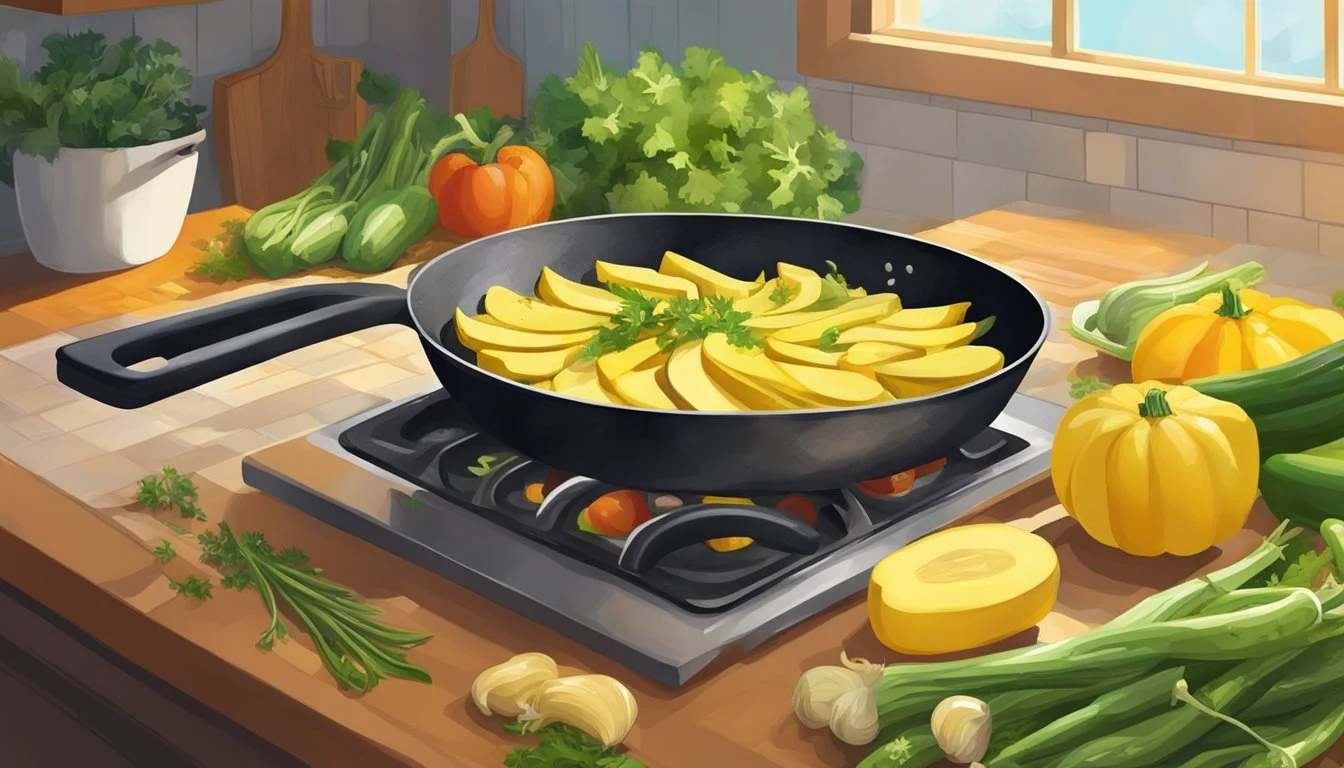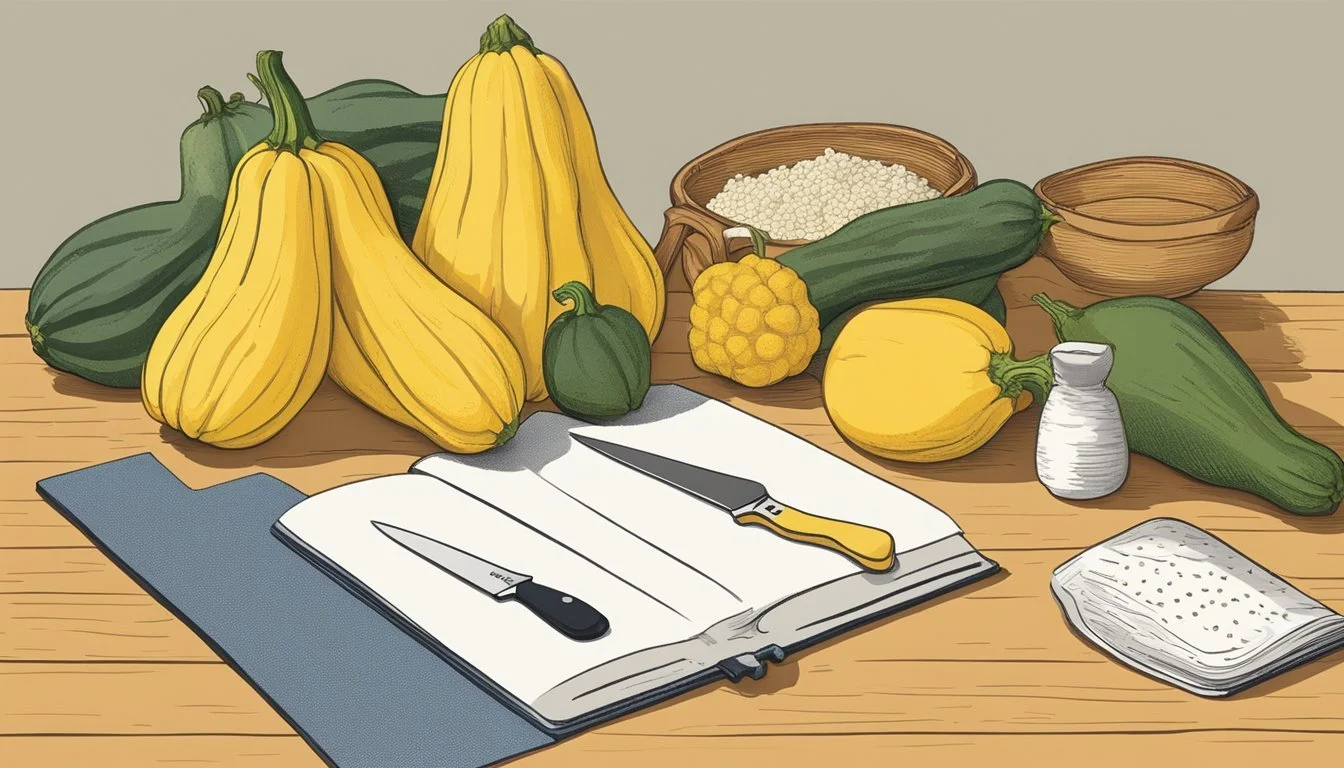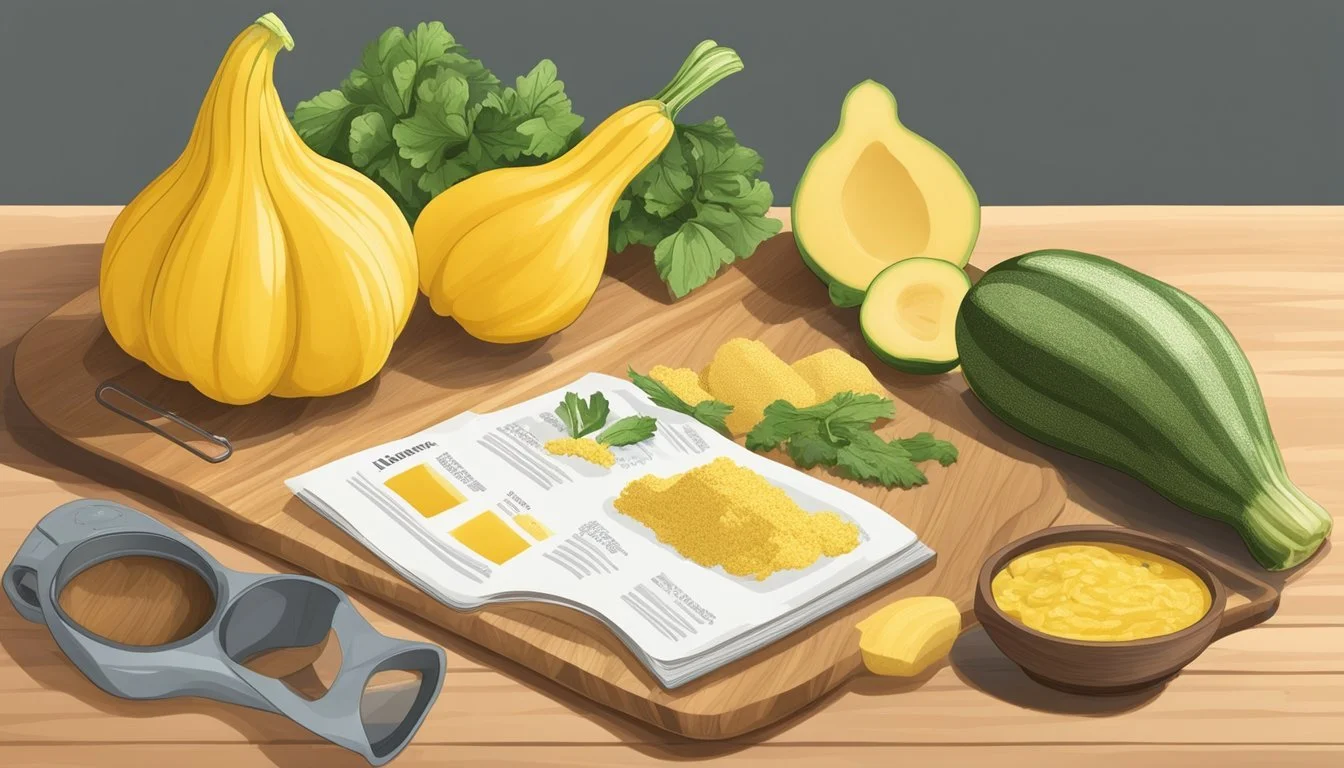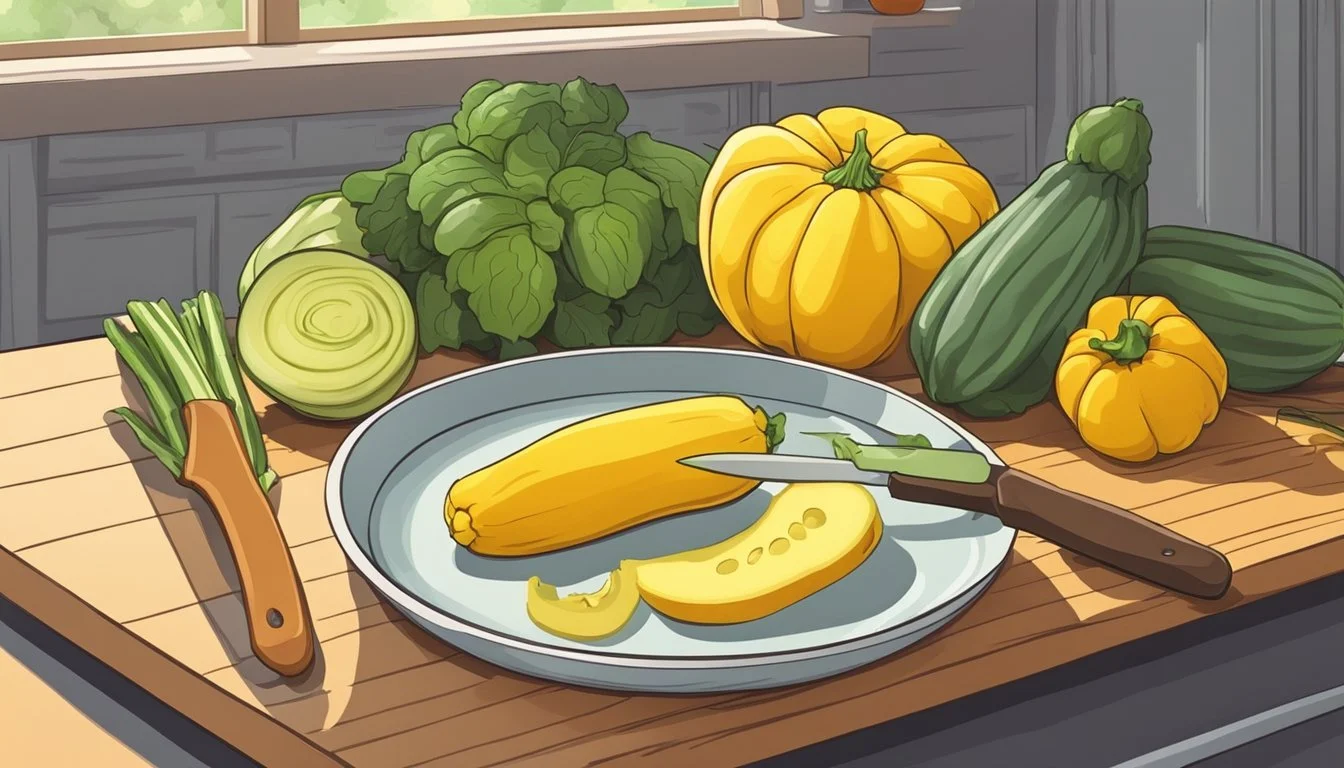How to Cook with Yellow Squash
Summer Fare Essentials
Yellow squash, often categorized under the broad term "summer squash," is a versatile and nutritious vegetable that eagerly takes its place in the summer culinary landscape. With its mild flavor and tender texture, it accommodates a vast array of cooking methods, making it a beloved component for chefs and home cooks alike. Packed with valuable nutrients such as Vitamin A, Vitamin C, and potassium, yellow squash not only brings a splash of color to summer plates but also contributes to a well-balanced diet.
The adaptability of yellow squash in the kitchen allows it to be transformed into a variety of dishes fit for any summer table. Whether sliced and steamed for a light side dish, cut into cubes and air-fried for a crisp addition to salads, or roasted in the oven to concentrate its natural sweetness, yellow squash can be prepared quickly and easily. Cooking methods such as sautéing in olive oil also highlight the subtle flavors of the squash, ensuring that it can be a simple yet elegant accompaniment to any main course.
When selecting yellow squash for cooking, look for ones that have a vibrant yellow color, are firm to the touch, and are relatively small to medium in size, as these tend to be less fibrous and more flavorful. Incorporating yellow squash into summer fare promises to elevate the seasonal eating experience, bringing both nutrition and pleasure to the palate with minimal effort.
Selecting the Best Yellow Squash
When looking for the highest quality yellow squash, one must assess both its freshness and appropriate size. These factors ensure the squash’s sweetness and tenderness, which are ideal for a variety of summer dishes.
Determining Freshness
A fresh yellow squash will have a bright, vibrant yellow skin that is free of blemishes and soft spots. The surface should be glossy, indicating that it has been recently picked. When pressed gently, the skin should give a little but not be too soft or mushy. Moreover, the stem should be intact and look relatively fresh, as a dry, withered stem is a sign of age.
Freshness Checklist:
Color: Bright, vibrant yellow
Surface: Glossy, without blemishes
Stem: Intact, not withered
Texture: Slightly firm to the touch
Choosing the Right Size
Size is indicative of the squash's maturity and potential flavor and texture. Generally, smaller to medium-sized yellow squash, about 6–8 inches in length, are the most tender and have the best flavor. Large yellow squash tend to have more seeds and may be less tender, affecting the overall texture when cooked.
When at the grocery store, avoid yellow squash that are overly large or have a thick, hard skin as these characteristics suggest that they are overripe and may have a tougher texture. Instead, opt for those that are small to medium in size and have a thinner, more delicate skin.
Size Guide:
Ideal Length: 6–8 inches
Skin: Thin and delicate
Tenderness: More tender with a smaller size
Preparation Basics
Cooking with yellow squash requires some essential techniques for washing and cutting, as well as several cooking methods to bring out its delicate flavor. These basic preparations will ensure the yellow squash retains its nutritional value and delicious taste.
Washing and Cutting Techniques
Washing: Before cooking, it's important to thoroughly wash the yellow squash to remove any dirt or residues. Gently scrub the skin under running water and pat dry with a clean towel.
Cutting: To cut yellow squash for cooking, first remove the stem and the blossom end, often referred to as the "belly button." Slice the squash into uniform pieces to ensure even cooking. Depending on the recipe, this could involve slicing into rounds, half-moons, or cubes.
Slicing Techniques:
For steaming or sautéing: Cut into 1/4-1/2-inch thick slices.
For roasting: Thinly slice into 1/4-inch coins for quicker cooking.
Essential Cooking Methods
Steaming: Steaming yellow squash preserves its texture and nutrients. Slice the squash and steam it over boiling water using a stovetop steamer for about 5-7 minutes or until tender.
Steamed Squash Instructions:
Place sliced squash in a steamer basket over boiling water.
Cover and steam for 5-7 minutes.
Season with salt and pepper to taste.
Roasting: Roasting yellow squash brings out a caramelized, rich flavor. Preheat the oven to 425°F (220°C), season the slices with olive oil, salt, pepper, and garlic if desired, and arrange in a single layer on a baking sheet.
Roasted Squash Instructions:
Coat squash slices with olive oil and seasonings.
Roast in preheated oven for 15-20 minutes or until golden brown and tender.
Sautéing: A quick sauté in olive oil over medium-high heat enhances the squash's natural sweetness. It's a rapid cooking method that results in a flavorful and tender side dish.
Sautéed Squash Instructions:
Heat olive oil in a skillet, add squash in an even layer.
Season with salt, pepper, and cook, stirring occasionally for 8-10 minutes.
Flavor Enhancements
The proper selection of flavor enhancements elevates the natural, mild taste of yellow squash. By using a combination of seasonings and cheeses, one can tailor the dish to suit any palate.
Seasoning Pairings
Yellow squash pairs well with a variety of herbs and seasonings to enhance its flavor. Key seasonings include:
Salt: Kosher salt or sea salt can be used to draw out moisture and concentrate flavors.
Pepper: Freshly ground black pepper adds a simple, piquant note.
Garlic: Minced or sliced garlic infuses the squash with a pungent, earthy flavor.
Lemon: A spritz of lemon juice brightens the dish with a touch of acidity.
Italian Seasoning: This blend of dried herbs offers a quick shortcut to complex flavors.
Fresh Herbs: Parsley, thyme, and other fresh herbs bring vibrant, aromatic notes to the squash.
- Kosher Salt - Enhances flavor
- Black Pepper - Adds a piquant note
- Minced Garlic - Infuses a pungent, earthy flavor
- Lemon Juice - Brightens the dish
- Italian Seasoning - Provides complex flavors
- Fresh Herbs (Parsley, Thyme) - Bring vibrant notesCheese Integrations
Cheese is a wonderful addition to yellow squash, providing both flavor and texture.
Parmesan: Grated parmesan cheese offers a salty and nutty taste that complements the squash's subtle sweetness.
Parmesan Crust: For a crispy texture, a parmesan cheese crust can be achieved by baking seasoned squash slices with a parmesan topping.
A simple approach to incorporating cheese into a yellow squash dish:
Toss yellow squash slices or cubes with olive oil.
Sprinkle with grated parmesan, kosher salt, and black pepper.
Bake or sauté until the cheese melts and creates a golden, savory exterior.
Cheese Pairings for Yellow Squash:
Cheese Type Preparation Suggestion Grated Parmesan Sprinkle on top before baking or sautéing Parmesan Crust Coat with cheese and bake for a crispy exterior
Using these enhancements, one can create a yellow squash dish that is rich in flavor and appealing in texture.
Cooking Techniques Detailed
Yellow squash is a versatile ingredient that can be cooked using a variety of techniques. Each method brings out different flavors and textures, perfect for summer dishes that require squash to be tender, yet hold its shape.
Mastering the Grill
Grilling yellow squash is a delightful way to achieve a smoky flavor. It’s important to preheat the grill to a medium-high heat before adding the squash. Slices should be about 1/2-inch thick and brushed with olive oil or extra virgin olive oil to prevent sticking. The squash is grilled until it shows grill marks and becomes tender, which usually takes just a few minutes on each side.
Roasting to Perfection
Roasting yellow squash is a simple process that enhances its natural sweetness. Preheat the oven to 425°F and prepare the squash by slicing it into 1/4-inch thick pieces to ensure even cooking. A light coating of olive oil on a baking sheet prevents sticking. The squash should be roasted until it’s tender and golden-brown, typically taking between 10-20 minutes, depending on the size of the pieces.
Sautéing for Texture
To sauté yellow squash, one should start with a hot sauté pan on medium heat. The squash, typically cut into uniform slices or cubes, should be seasoned and then cooked with olive oil until it's light golden-brown. The key to sautéing is to allow the squash to become tender without overcooking, usually achieved in about 8-10 minutes, stirring occasionally for an even texture.
Innovating with the Air Fryer
Using an air fryer to cook yellow squash creates a crispy texture that’s hard to resist. Start by cutting the squash into even slices or halves and toss them with a touch of olive oil. Air fry at a temperature of around 400°F, checking periodically, until the squash is crispy and golden, which generally takes 10-15 minutes. The air fryer offers a healthier alternative to frying while still providing that satisfying crunch.
Companion Dishes
When incorporating yellow squash into summer meals, one can expertly pair it with a variety of vegetables and proteins to enhance the overall dining experience. These pairings can turn simple yellow squash into a cohesive part of the meal.
Vegetable Pairings
Yellow squash mingles well with an array of vegetables to create a vibrant side dish. Onions and yellow squash can be sautéed together, allowing their natural sweetness to complement each other. Adding a pinch of red pepper flakes can introduce a gentle heat, perfect for those who enjoy a bit of spice. For another enticing combination, one might consider:
Red bell peppers: Their bright, sweet flavor balances the mildness of yellow squash.
Zucchini: Often used in tandem with yellow squash for a colorful and harmonious mix.
Tomatoes: Their acidity can brighten the dish and add a juicy texture contrast.
These vegetables can be prepared together in a skillet, or layered in a casserole and baked for a delightful summer side dish.
Matching with Proteins
Yellow squash pairs efficiently with various meats, serving as an accompanying side that can play a supporting role to the main protein or be weaved into a meat-centric main dish. For instance:
Chicken: Yellow squash can be included in a chicken stir-fry, complementing the tender meat with its subtle flavor and adding a healthful crunch.
Beef: When combined with pieces of beef in a kebab, it absorbs flavors and adds a juicy component to each bite.
Bacon: The smokiness of bacon contrasts nicely with the mildness of the squash. Diced and fried together, they make for a crowd-pleasing dish.
Properly prepared, yellow squash can enhance the flavors of these proteins while adding nutritional value and visual appeal to the plate.
Post-Cooking Tips
After enjoying a meal with yellow squash, it is important to store any leftovers properly to maintain their quality and taste. The following tips ensure that your yellow squash dishes remain delicious and safe to consume when stored and reheated.
Storing Leftovers
One can store yellow squash leftovers in the refrigerator to keep them fresh. They should be placed in an airtight container to prevent them from becoming soggy and to retain their flavor. It's advisable to consume refrigerated squash within three to five days to avoid spoilage.
Refrigerator Storage: Up to 3-5 days in an airtight container.
Freezer Storage: Not recommended, as squash can become mushy once thawed.
Recipe Reheating Methods
When reheating yellow squash, one should be careful not to overcook it to prevent the squash from turning mushy. Here are some effective methods:
Microwave: Use a microwave-safe dish, cover it to retain moisture, and reheat on a medium setting for short intervals, checking frequently.
Oven: Reheat at a moderate temperature, such as 350°F, until just warm.
Method Temperature Duration Microwave Medium setting 1-2 minutes Oven 350°F (175°C) 10-15 minutes
These approaches ensure yellow squash leftovers are warmed thoroughly without compromising texture.
Nutritional Information
Yellow squash, also known as summer squash, is a nutritious vegetable that provides numerous health benefits. It is low in calories but high in fiber, making it an excellent choice for those looking to maintain a healthy diet.
Calories: One cup of sliced yellow squash contains approximately 20 calories, making it a low-calorie food ideal for weight management.
Protein: Each cup contains around 1.5 grams of protein, contributing to muscle maintenance and overall health.
Fiber: With 1.3 grams per cup, the fiber in yellow squash supports digestive health and can help to regulate blood sugar levels.
Potassium: This vegetable is a good source of potassium, with one cup providing around 295 milligrams, which is vital for heart health and maintaining proper muscle and nerve functions.
In terms of vitamins, yellow squash is especially high in vitamin C, important for immune function, and vitamin A, which promotes good vision and skin health. It also provides:
Vitamin B6
Vitamin K
Vitamin E
Folate: Additionally, yellow squash contains folate, a B-vitamin necessary for cell division and the formation of DNA, with a cup offering about 36 micrograms.
This vegetable is also rich in antioxidants, which can help protect the body from oxidative stress and inflammation. Including yellow squash in one's diet is not just beneficial for its nutrients, but also for its versatility in cooking, which makes it easy to incorporate into meals.
Recipe Ideas and Variations
When cooking with yellow squash, its versatility allows for a multitude of culinary explorations. From vegetarian entrees to innovative takes on classic dishes, yellow squash can be transformed into both simple side dishes and the centerpiece of a meal.
Vegetarian and Vegan Options
Vegetarians and vegans can relish in the ease of preparing yellow squash. An easy vegetable side dish involves sautéing slices of yellow squash in olive oil and seasoning with herbs; this allows the natural flavors to shine. For a heartier vegan option, one could create a yellow squash lasagna, replacing traditional lasagna noodles with thin strips of squash and layering with plant-based cheese and a rich tomato sauce.
Creative Twists on Classics
One can elevate the common recipe card with inventive yellow squash recipes that put a twist on familiar favorites. Adding grilled yellow squash, with its slightly smoky flavor, to a summer vegetable pasta not only boosts nutriment but also adds complexity to the dish. Alternatively, incorporating diced, sautéed yellow squash into a frittata introduces a tender texture and a subtle, sweet undertone.
Expanding Beyond the Side Dish
Yellow squash need not be relegated to the side; it stands out as a main dish as well. Grilling yellow squash after marinating it in a mix of herbs and lemon juice transforms it into a main dish worthy of summer barbecues. Equally, stuffing the squash with a mix of quinoa, black beans, corn, and spices can round out a meal with a satisfying and nutritious center plate offering.
Final Thoughts
Yellow squash is a versatile and nutritious addition to one's summer meal repertoire. When incorporating this vegetable into meal prep, it lends itself well to being batch cooked in various ways. One can steam, grill, roast, sauté, or air-fry the squash efficiently, making it an excellent choice for quick and healthy meals throughout the week.
For those seeking practical cooking tips, yellow squash is best enjoyed when cooked to tenderness yet retaining a bit of bite. It can be seasoned simply with salt, pepper, and olive oil, or enhanced with garlic, herbs, and Parmesan cheese for heightened flavor.
Key Tips:
Slice Evenly: Consistent thickness ensures even cooking.
Season Well: Balance spices and herbs to complement its mild taste.
Avoid Overcooking: Preserve the texture and nutritional content.
Remember, when working with yellow squash, it's important to understand that its high water content requires consideration. For example, one wouldn't want to over-saturate it when steaming; just a bit of water will suffice. Similarly, when using seasoning, pairing it with something that has an affinity for moisture, such as salt or lemon juice, will help draw out flavors while cooking and reduce wateriness.
Incorporating yellow squash into dishes not only adds a nutritional boost but also a splash of color and a gentle, sweet flavor that pairs beautifully with a variety of ingredients. Whether one is a seasoned cook or a beginner in the kitchen, they can approach cooking yellow squash with confidence, utilizing the tips provided to enhance their culinary creations.








